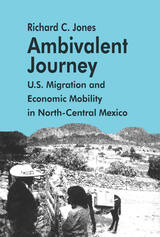2 books about Economic Mobility

Ambivalent Journey
U.S. Migration and Economic Mobility in North-Central Mexico
Richard C. Jones
University of Arizona Press, 1995
The changing political and economic relationships between Mexico and the United States, and the concurrent U.S. debate over immigration policy and practice, demand new data on migration and its economic effects. In this innovative study, Richard C. Jones analyzes migration patterns from two subregions of north-central Mexico, Coahuila and Zacatecas, to the United States. He analyzes and contrasts the characteristics of the two migrant populations and interprets the economic impacts of migration upon both home of migration upon both home areas. Jones's findings refute some common assumptions about Mexican migration while providing a strong model for further research.
Jones's study focuses on the ways in which U.S. migration affects the lives of families in these two subregions. Migrants from Zacatecas have traditionally come from rural areas and have gone to California and Illinois. Migrants from Coahuila, on the other hand, usually come from urban areas and have almost exclusively preferred locations in nearby Texas. The different motivations of both groups for migrating, and the different economic and social effects upon their home areas realized by migrating, form the core of this book. The comparison also lends the book its uniqueness, since no other study has made such an in-depth comparison of two areas.
Jones addresses the basic dichotomy of structuralists (who maintain that dependency and disinvestment are the rule for families and communities in sending areas) and functionalists (who believe that autonomy and reinvestment are the case of migrants and their families in home regions). Jones finds that much of the primary literature is based on uneven and largely outdated data that leans heavily on two sending states, Jalisco and Michoacan. His fresh analysis shows that communities and regions of Mexico, rather than families only, account for differing migration patterns and differing social and economic results of these patterns.
Jones's study will be of value not only to scholars and practitioners working in the field of Mexican migration, but also, for its innovative methodology, to anthropologists, sociologists, political scientists, and historians whose interests include human migration patterns in any part of the world
Jones's study focuses on the ways in which U.S. migration affects the lives of families in these two subregions. Migrants from Zacatecas have traditionally come from rural areas and have gone to California and Illinois. Migrants from Coahuila, on the other hand, usually come from urban areas and have almost exclusively preferred locations in nearby Texas. The different motivations of both groups for migrating, and the different economic and social effects upon their home areas realized by migrating, form the core of this book. The comparison also lends the book its uniqueness, since no other study has made such an in-depth comparison of two areas.
Jones addresses the basic dichotomy of structuralists (who maintain that dependency and disinvestment are the rule for families and communities in sending areas) and functionalists (who believe that autonomy and reinvestment are the case of migrants and their families in home regions). Jones finds that much of the primary literature is based on uneven and largely outdated data that leans heavily on two sending states, Jalisco and Michoacan. His fresh analysis shows that communities and regions of Mexico, rather than families only, account for differing migration patterns and differing social and economic results of these patterns.
Jones's study will be of value not only to scholars and practitioners working in the field of Mexican migration, but also, for its innovative methodology, to anthropologists, sociologists, political scientists, and historians whose interests include human migration patterns in any part of the world
[more]

Divergent Paths
Economic Mobility in the New American Labor Market
Annette Bernhardt
Russell Sage Foundation, 2001
The promise of upward mobility—the notion that everyone has the chance to get ahead—is one of this country's most cherished ideals, a hallmark of the American Dream. But in today's volatile labor market, the tradition of upward mobility for all may be a thing of the past. In a competitive world of deregulated markets and demanding shareholders, many firms that once offered the opportunity for advancement to workers have remade themselves as leaner enterprises with more flexible work forces. Divergent Paths examines the prospects for upward mobility of workers in this changed economic landscape. Based on an innovative comparison of the fortunes of two generations of young, white men over the course of their careers, Divergent Paths documents the divide between the upwardly mobile and the growing numbers of workers caught in the low-wage trap. The first generation entered the labor market in the late 1960s, a time of prosperity and stability in the U.S. labor market, while the second generation started work in the early 1980s, just as the new labor market was being born amid recession, deregulation, and the weakening of organized labor. Tracking both sets of workers over time, the authors show that the new labor market is more volatile and less forgiving than the labor market of the 1960s and 1970s. Jobs are less stable, and the penalties for failing to find a steady employer are more severe for most workers. At the top of the job pyramid, the new nomads—highly credentialed, well-connected workers—regard each short-term project as a springboard to a better-paying position, while at the bottom, a growing number of retail workers, data entry clerks, and telemarketers, are consigned to a succession of low-paying, dead-end jobs. While many commentators dismiss public anxieties about job insecurity as overblown, Divergent Paths carefully documents hidden trends in today's job market which confirm many of the public's fears. Despite the celebrated job market of recent years, the authors show that the old labor market of the 1960s and 1970s propelled more workers up the earnings ladder than does today's labor market. Divergent Paths concludes with a discussion of policy strategies, such as regional partnerships linking corporate, union, government, and community resources, which may help repair the career paths that once made upward mobility a realistic ambition for all American workers.
[more]
READERS
Browse our collection.
PUBLISHERS
See BiblioVault's publisher services.
STUDENT SERVICES
Files for college accessibility offices.
UChicago Accessibility Resources
home | accessibility | search | about | contact us
BiblioVault ® 2001 - 2024
The University of Chicago Press









